The followers of Caodaism in foreign countries and the administrative relation between believers of Caodaism in foreign countries and Cao Dai church in country
Caodaism was established in the South in 1926. It has been considered as one of
indigenous religions in Vietnam in the first half of 20th century. In the first days,
trend of Caodaism was to develop in foreign countries through missionary
campaigns. Cao Dai’s dignitaries carried out missionary task in Cambodia,
France, German, China That was why followers of Cao Dai (Cao Dai followers)
lived in these countries in the early 1930s. After 1975 many people in the South
emigrated to America, Australia. Many of them were Cao Dai followers. After their
lives have been stabilized, they have gathered to build temples so Caodaism in
foreign countries has developed strongly. The number of believers in foreign
countries is about 50,000 believers. They have created connection with Cao Dai
sects through many forms. In this article we mention three main contents: 1) Cao
Dai followers in foreign countries: the process of establishment and development
after 1975; 2) The administrative relation between Cao Dai followers in foreign
countries and Cao Dai church in Vietnam; 3) Some remarks on the administrative
relation. The information in this article has been completed with two research
methods: in-depth interview and participate observation.
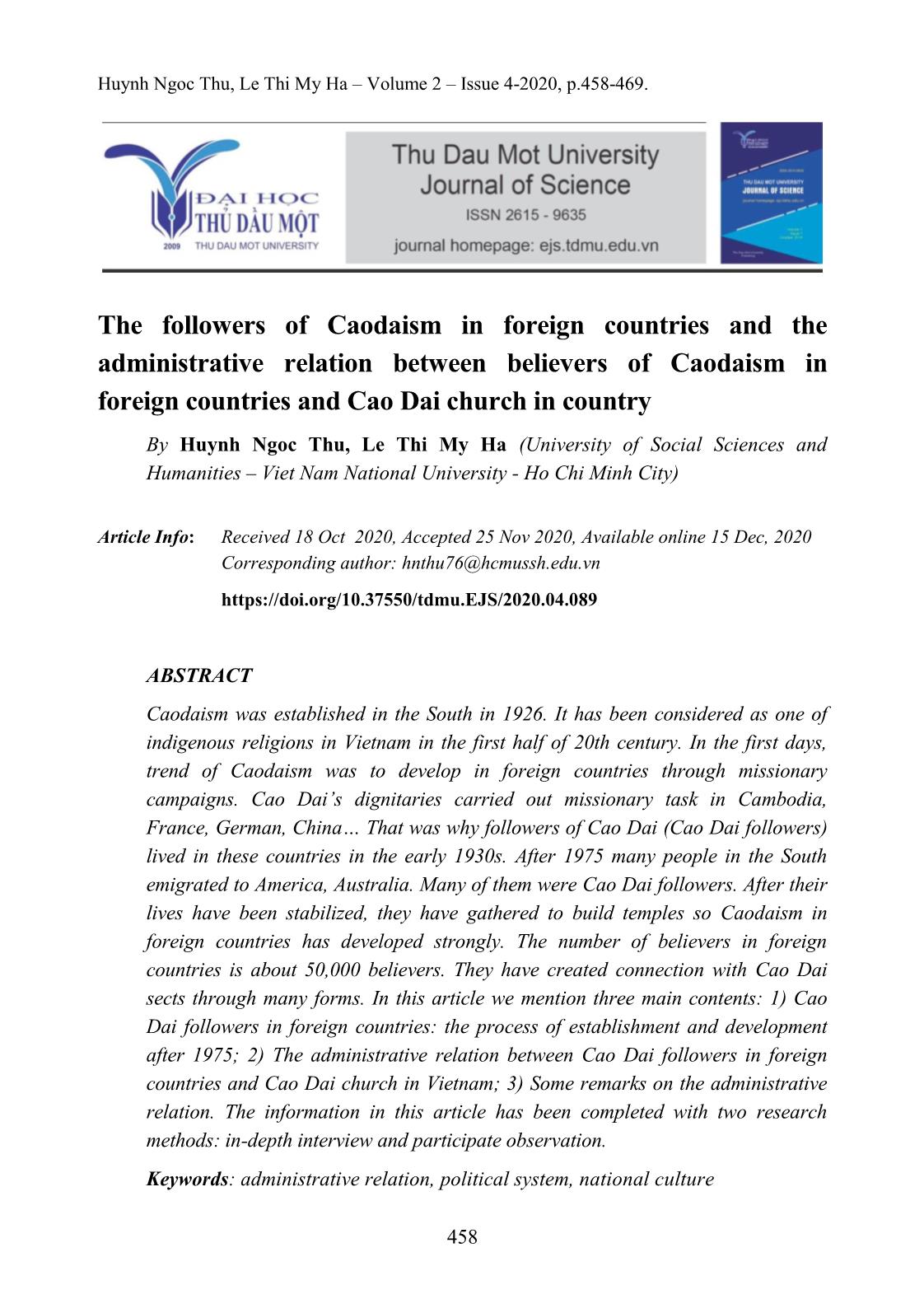
Trang 1
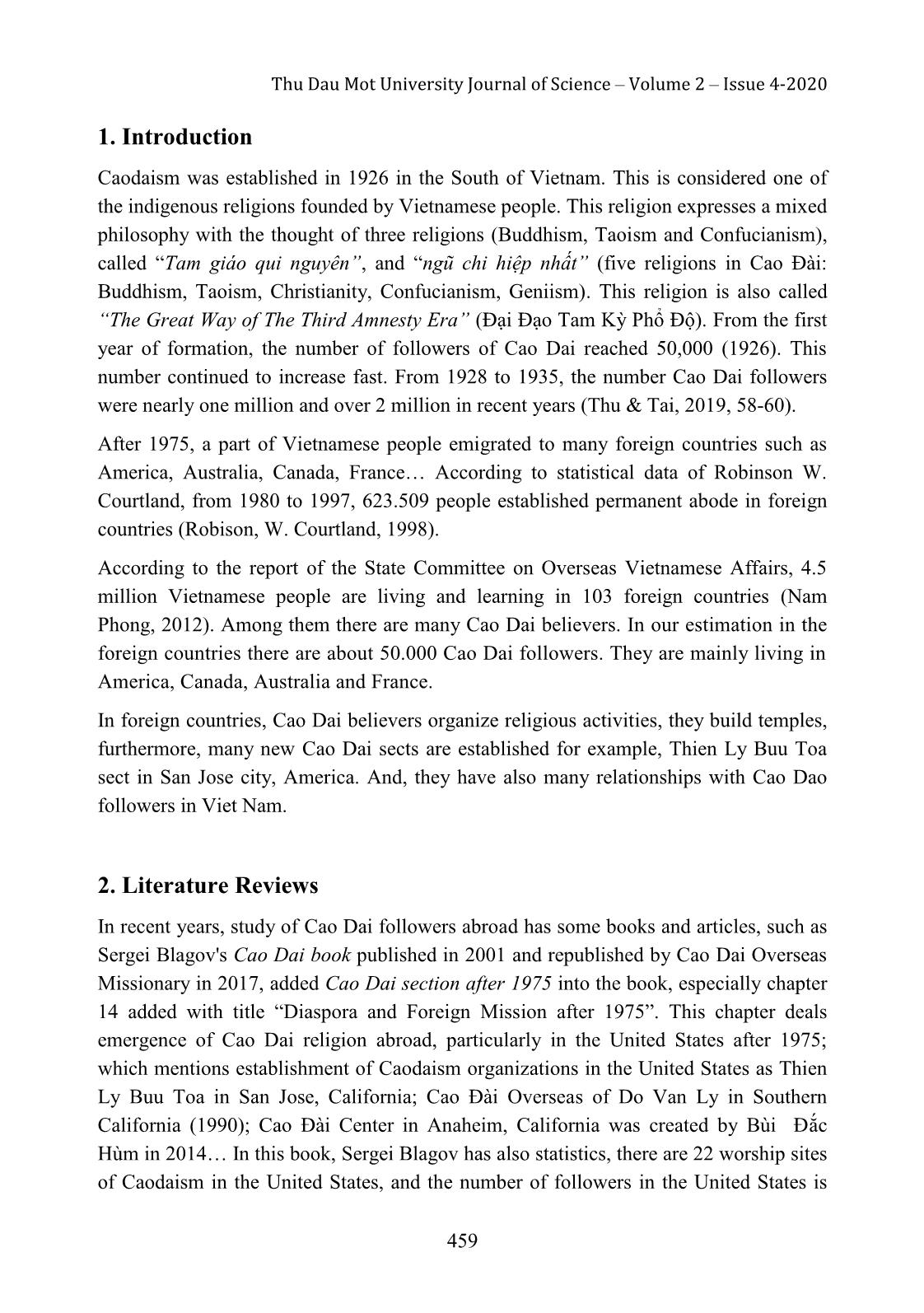
Trang 2
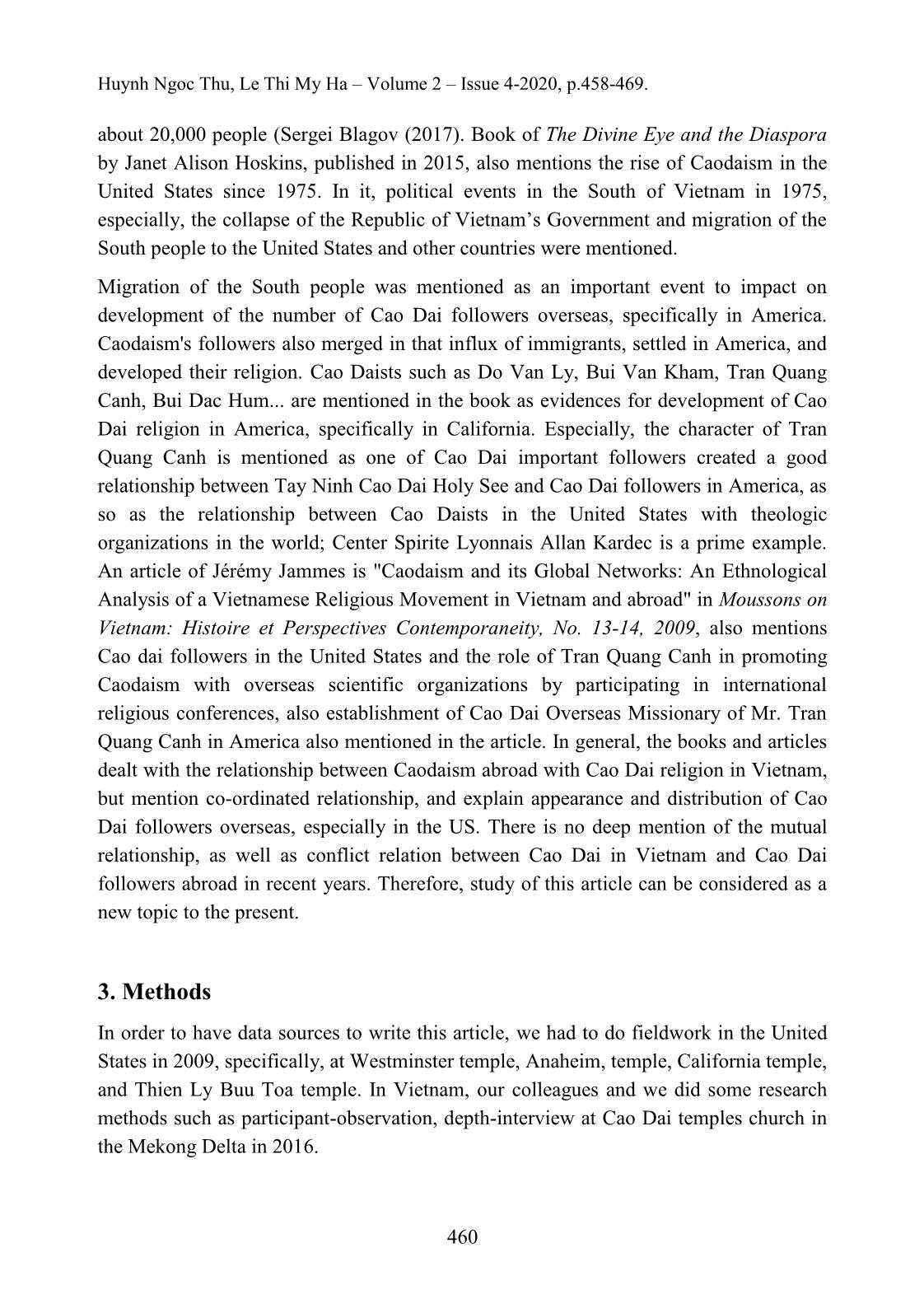
Trang 3
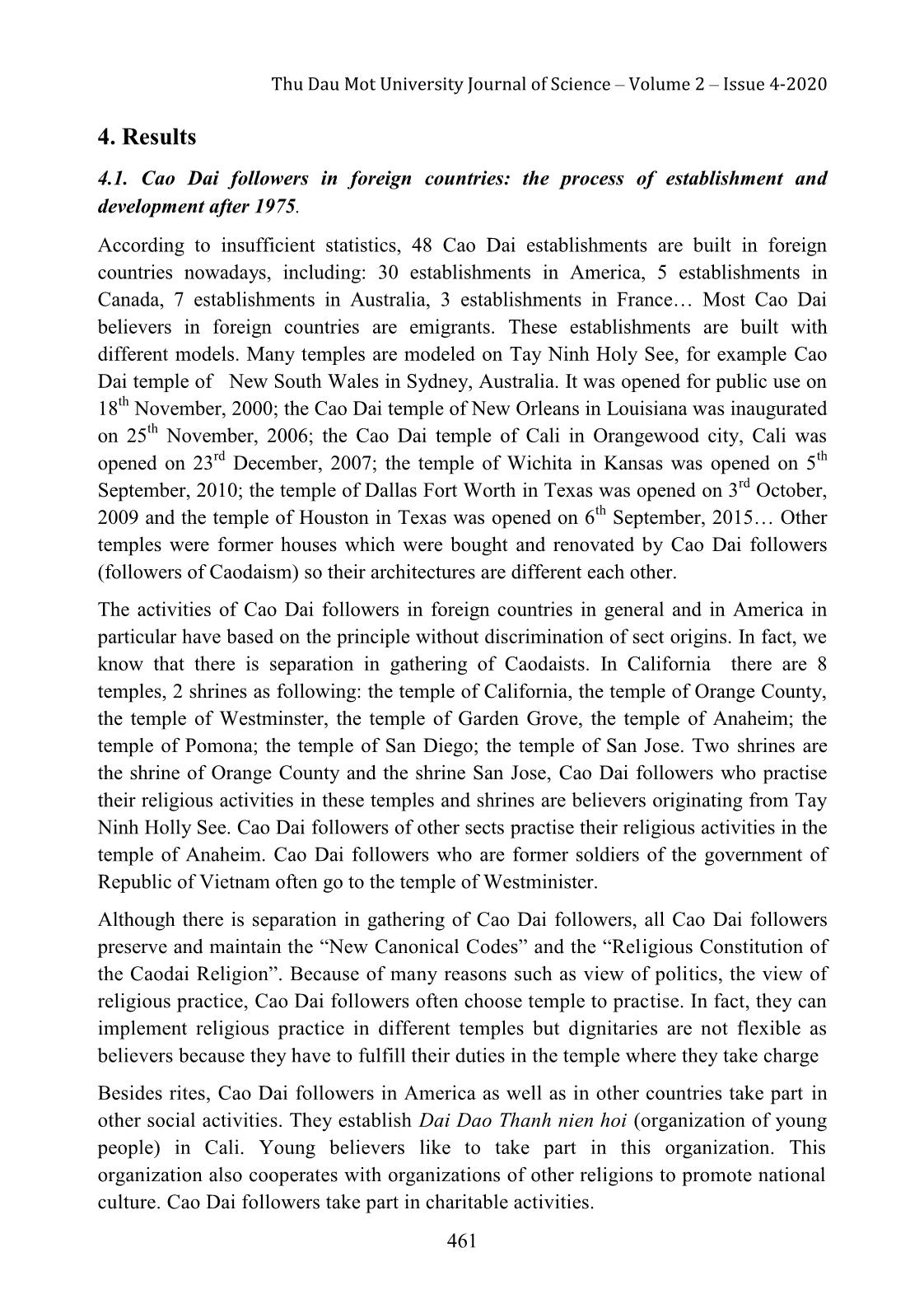
Trang 4
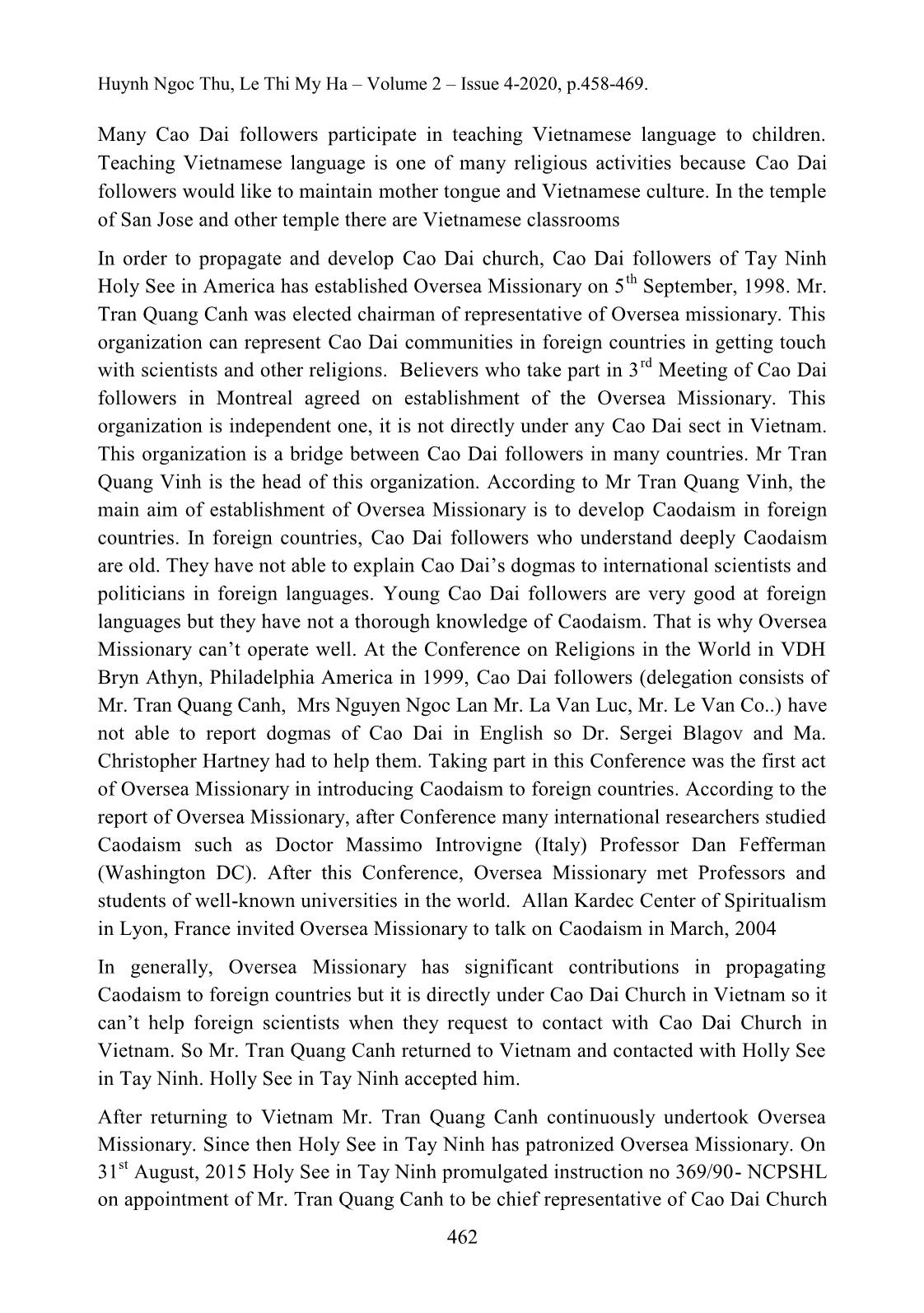
Trang 5
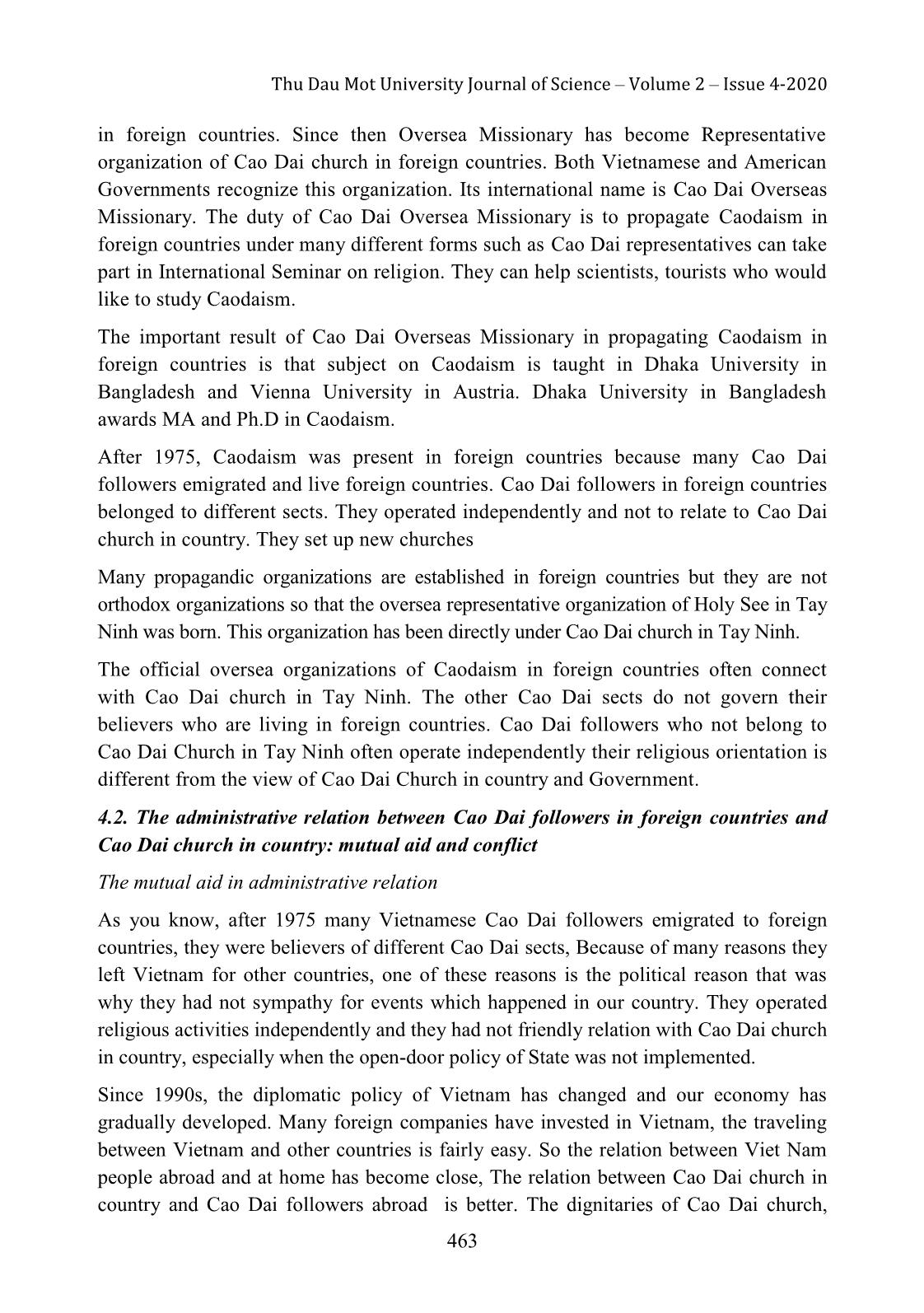
Trang 6
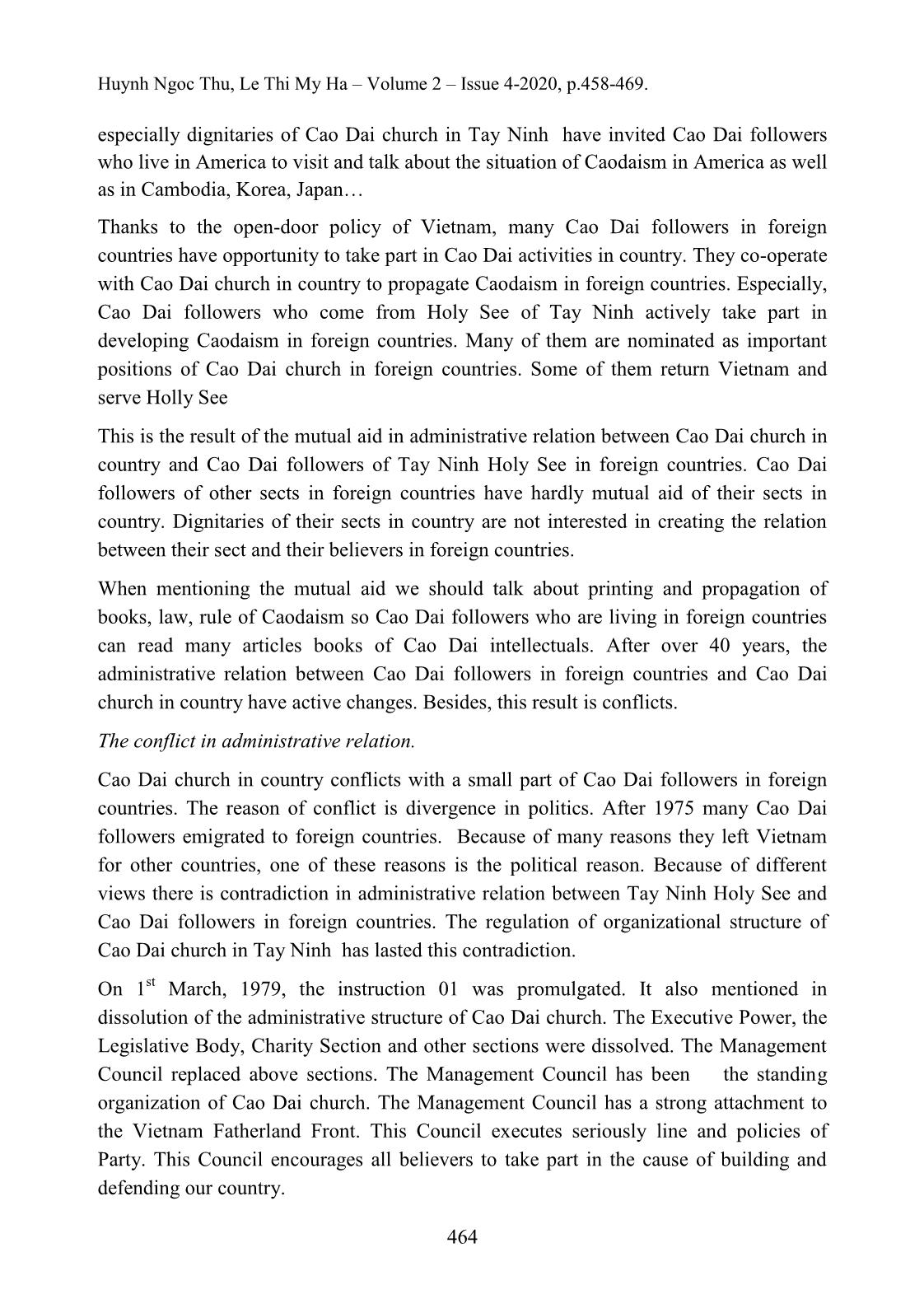
Trang 7
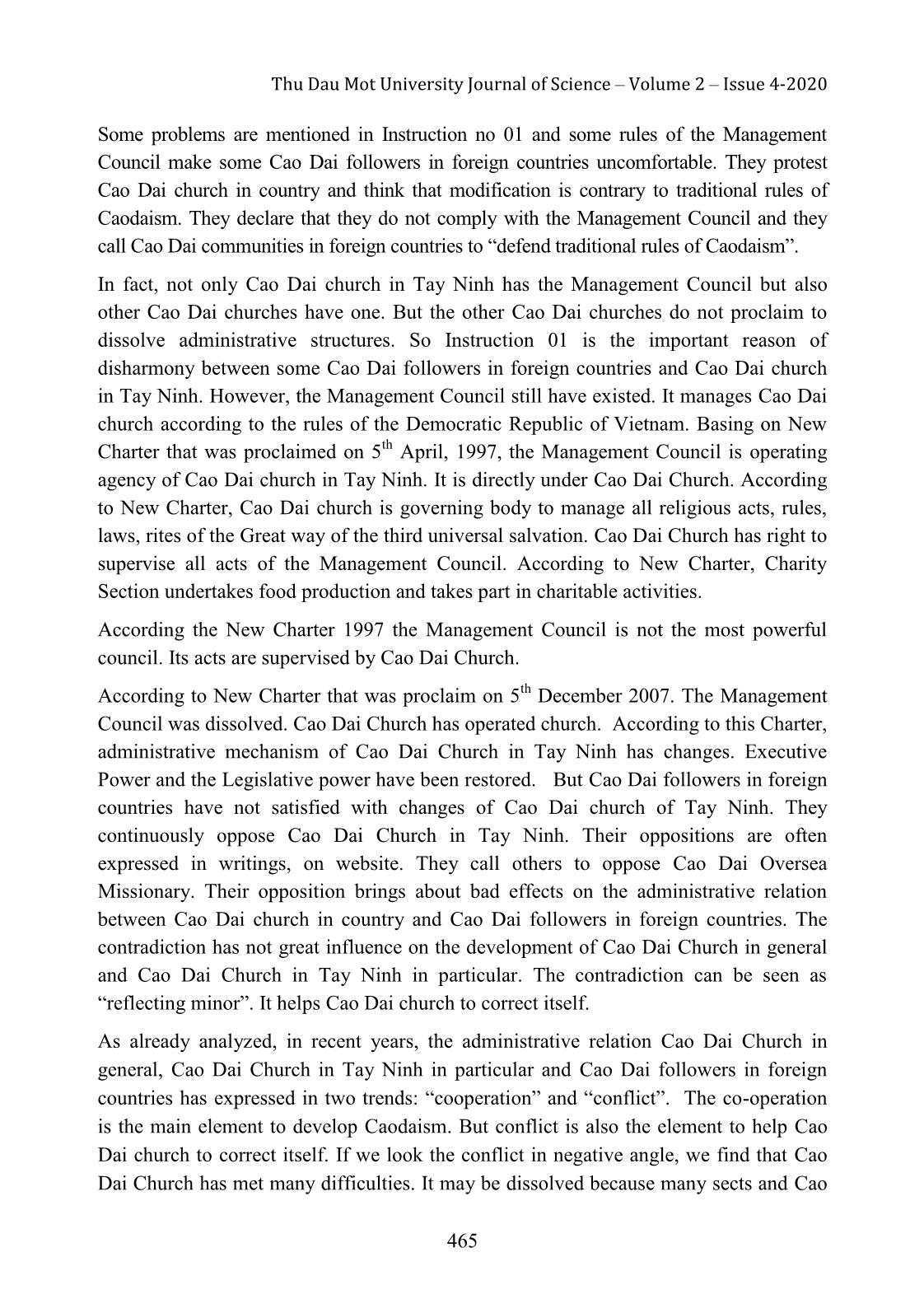
Trang 8
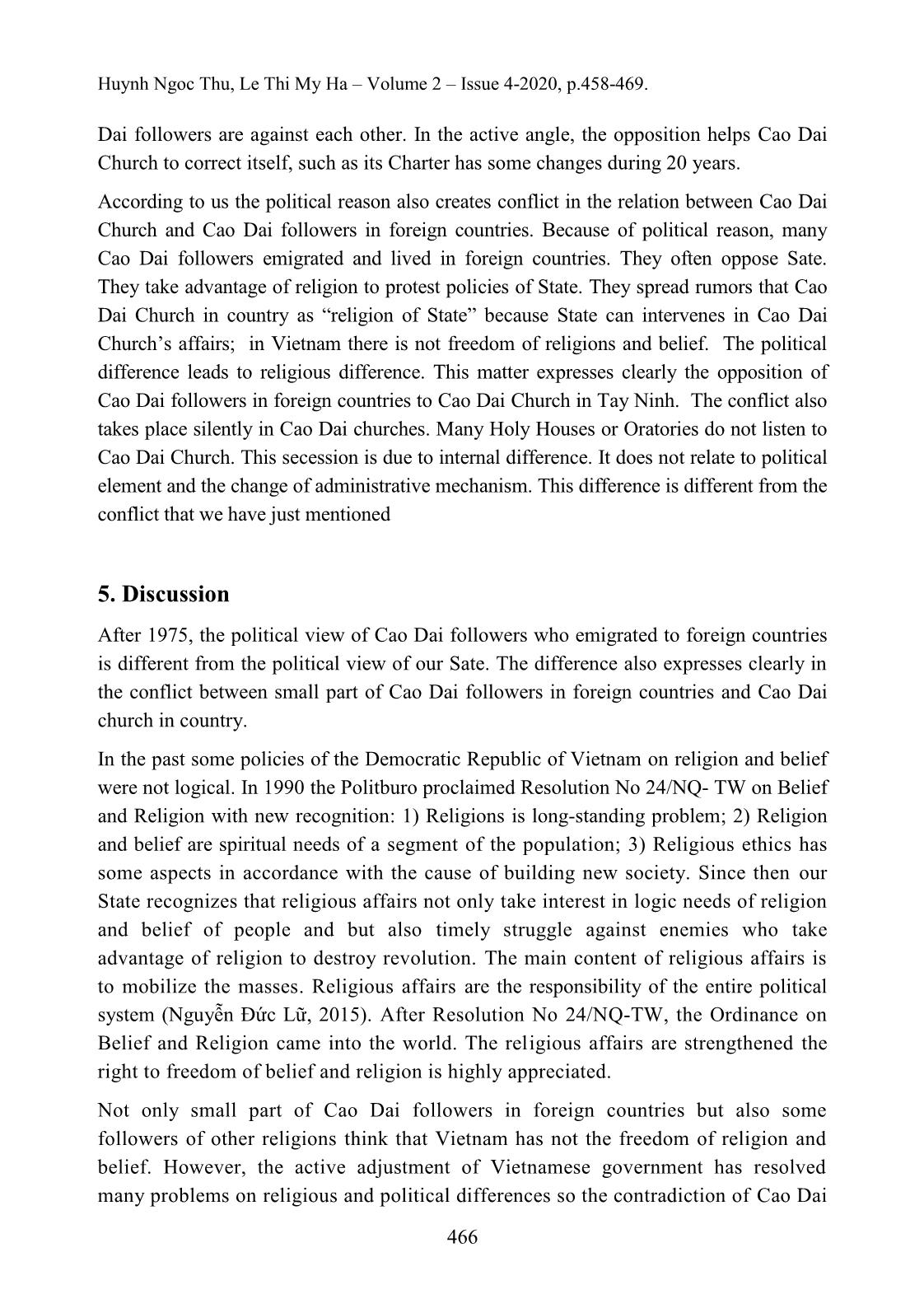
Trang 9
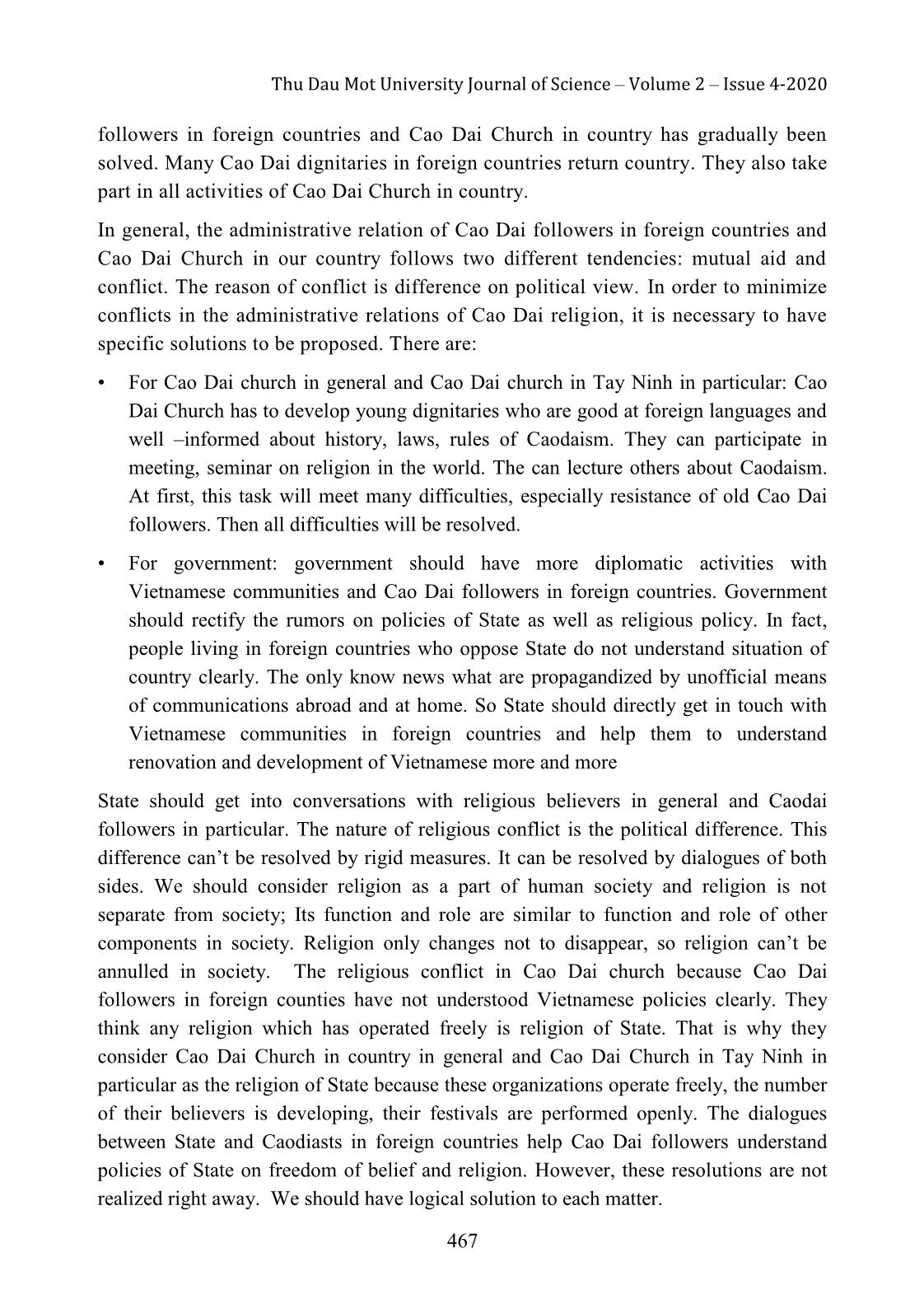
Trang 10
Tải về để xem bản đầy đủ
Tóm tắt nội dung tài liệu: The followers of Caodaism in foreign countries and the administrative relation between believers of Caodaism in foreign countries and Cao Dai church in country
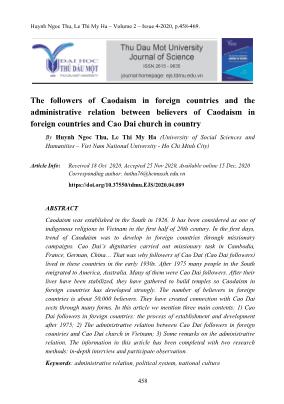
result is conflicts. The conflict in administrative relation. Cao Dai church in country conflicts with a small part of Cao Dai followers in foreign countries. The reason of conflict is divergence in politics. After 1975 many Cao Dai followers emigrated to foreign countries. Because of many reasons they left Vietnam for other countries, one of these reasons is the political reason. Because of different views there is contradiction in administrative relation between Tay Ninh Holy See and Cao Dai followers in foreign countries. The regulation of organizational structure of Cao Dai church in Tay Ninh has lasted this contradiction. On 1st March, 1979, the instruction 01 was promulgated. It also mentioned in dissolution of the administrative structure of Cao Dai church. The Executive Power, the Legislative Body, Charity Section and other sections were dissolved. The Management Council replaced above sections. The Management Council has been the standing organization of Cao Dai church. The Management Council has a strong attachment to the Vietnam Fatherland Front. This Council executes seriously line and policies of Party. This Council encourages all believers to take part in the cause of building and defending our country. 464 Thu Dau Mot University Journal of Science – Volume 2 – Issue 4-2020 Some problems are mentioned in Instruction no 01 and some rules of the Management Council make some Cao Dai followers in foreign countries uncomfortable. They protest Cao Dai church in country and think that modification is contrary to traditional rules of Caodaism. They declare that they do not comply with the Management Council and they call Cao Dai communities in foreign countries to “defend traditional rules of Caodaism”. In fact, not only Cao Dai church in Tay Ninh has the Management Council but also other Cao Dai churches have one. But the other Cao Dai churches do not proclaim to dissolve administrative structures. So Instruction 01 is the important reason of disharmony between some Cao Dai followers in foreign countries and Cao Dai church in Tay Ninh. However, the Management Council still have existed. It manages Cao Dai church according to the rules of the Democratic Republic of Vietnam. Basing on New Charter that was proclaimed on 5th April, 1997, the Management Council is operating agency of Cao Dai church in Tay Ninh. It is directly under Cao Dai Church. According to New Charter, Cao Dai church is governing body to manage all religious acts, rules, laws, rites of the Great way of the third universal salvation. Cao Dai Church has right to supervise all acts of the Management Council. According to New Charter, Charity Section undertakes food production and takes part in charitable activities. According the New Charter 1997 the Management Council is not the most powerful council. Its acts are supervised by Cao Dai Church. According to New Charter that was proclaim on 5th December 2007. The Management Council was dissolved. Cao Dai Church has operated church. According to this Charter, administrative mechanism of Cao Dai Church in Tay Ninh has changes. Executive Power and the Legislative power have been restored. But Cao Dai followers in foreign countries have not satisfied with changes of Cao Dai church of Tay Ninh. They continuously oppose Cao Dai Church in Tay Ninh. Their oppositions are often expressed in writings, on website. They call others to oppose Cao Dai Oversea Missionary. Their opposition brings about bad effects on the administrative relation between Cao Dai church in country and Cao Dai followers in foreign countries. The contradiction has not great influence on the development of Cao Dai Church in general and Cao Dai Church in Tay Ninh in particular. The contradiction can be seen as “reflecting minor”. It helps Cao Dai church to correct itself. As already analyzed, in recent years, the administrative relation Cao Dai Church in general, Cao Dai Church in Tay Ninh in particular and Cao Dai followers in foreign countries has expressed in two trends: “cooperation” and “conflict”. The co-operation is the main element to develop Caodaism. But conflict is also the element to help Cao Dai church to correct itself. If we look the conflict in negative angle, we find that Cao Dai Church has met many difficulties. It may be dissolved because many sects and Cao 465 Huynh Ngoc Thu, Le Thi My Ha – Volume 2 – Issue 4-2020, p.458-469. Dai followers are against each other. In the active angle, the opposition helps Cao Dai Church to correct itself, such as its Charter has some changes during 20 years. According to us the political reason also creates conflict in the relation between Cao Dai Church and Cao Dai followers in foreign countries. Because of political reason, many Cao Dai followers emigrated and lived in foreign countries. They often oppose Sate. They take advantage of religion to protest policies of State. They spread rumors that Cao Dai Church in country as “religion of State” because State can intervenes in Cao Dai Church’s affairs; in Vietnam there is not freedom of religions and belief. The political difference leads to religious difference. This matter expresses clearly the opposition of Cao Dai followers in foreign countries to Cao Dai Church in Tay Ninh. The conflict also takes place silently in Cao Dai churches. Many Holy Houses or Oratories do not listen to Cao Dai Church. This secession is due to internal difference. It does not relate to political element and the change of administrative mechanism. This difference is different from the conflict that we have just mentioned 5. Discussion After 1975, the political view of Cao Dai followers who emigrated to foreign countries is different from the political view of our Sate. The difference also expresses clearly in the conflict between small part of Cao Dai followers in foreign countries and Cao Dai church in country. In the past some policies of the Democratic Republic of Vietnam on religion and belief were not logical. In 1990 the Politburo proclaimed Resolution No 24/NQ- TW on Belief and Religion with new recognition: 1) Religions is long-standing problem; 2) Religion and belief are spiritual needs of a segment of the population; 3) Religious ethics has some aspects in accordance with the cause of building new society. Since then our State recognizes that religious affairs not only take interest in logic needs of religion and belief of people and but also timely struggle against enemies who take advantage of religion to destroy revolution. The main content of religious affairs is to mobilize the masses. Religious affairs are the responsibility of the entire political system (Nguyễn Đức Lữ, 2015). After Resolution No 24/NQ-TW, the Ordinance on Belief and Religion came into the world. The religious affairs are strengthened the right to freedom of belief and religion is highly appreciated. Not only small part of Cao Dai followers in foreign countries but also some followers of other religions think that Vietnam has not the freedom of religion and belief. However, the active adjustment of Vietnamese government has resolved many problems on religious and political differences so the contradiction of Cao Dai 466 Thu Dau Mot University Journal of Science – Volume 2 – Issue 4-2020 followers in foreign countries and Cao Dai Church in country has gradually been solved. Many Cao Dai dignitaries in foreign countries return country. They also take part in all activities of Cao Dai Church in country. In general, the administrative relation of Cao Dai followers in foreign countries and Cao Dai Church in our country follows two different tendencies: mutual aid and conflict. The reason of conflict is difference on political view. In order to minimize conflicts in the administrative relations of Cao Dai religion, it is necessary to have specific solutions to be proposed. There are: • For Cao Dai church in general and Cao Dai church in Tay Ninh in particular: Cao Dai Church has to develop young dignitaries who are good at foreign languages and well –informed about history, laws, rules of Caodaism. They can participate in meeting, seminar on religion in the world. The can lecture others about Caodaism. At first, this task will meet many difficulties, especially resistance of old Cao Dai followers. Then all difficulties will be resolved. • For government: government should have more diplomatic activities with Vietnamese communities and Cao Dai followers in foreign countries. Government should rectify the rumors on policies of State as well as religious policy. In fact, people living in foreign countries who oppose State do not understand situation of country clearly. The only know news what are propagandized by unofficial means of communications abroad and at home. So State should directly get in touch with Vietnamese communities in foreign countries and help them to understand renovation and development of Vietnamese more and more State should get into conversations with religious believers in general and Caodai followers in particular. The nature of religious conflict is the political difference. This difference can’t be resolved by rigid measures. It can be resolved by dialogues of both sides. We should consider religion as a part of human society and religion is not separate from society; Its function and role are similar to function and role of other components in society. Religion only changes not to disappear, so religion can’t be annulled in society. The religious conflict in Cao Dai church because Cao Dai followers in foreign counties have not understood Vietnamese policies clearly. They think any religion which has operated freely is religion of State. That is why they consider Cao Dai Church in country in general and Cao Dai Church in Tay Ninh in particular as the religion of State because these organizations operate freely, the number of their believers is developing, their festivals are performed openly. The dialogues between State and Caodiasts in foreign countries help Cao Dai followers understand policies of State on freedom of belief and religion. However, these resolutions are not realized right away. We should have logical solution to each matter. 467 Huynh Ngoc Thu, Le Thi My Ha – Volume 2 – Issue 4-2020, p.458-469. 6. Conclusion The relationship between the Cao Dai religion in Vietnam and the Cao Dai followers abroad has been manifested right from the beginning of this religion spreading abroad. However, depending on each period of history, this relationship has different changes. Prior to 1975, the relationship between domestic Cao Dai institutions and Cao Dai followers abroad was largely based on religious affiliation and development, without any significant conflict or opposition. But since 1975, because of diplomatic policies of the Socialist Republic of Vietnam and the Western word where most of foreign Cao Dai followers immigrated, political conflicts emerged thus leading to opposition. This opposition also affects a group of anti-communist domestic followers and resulted in instability. However, this has not negatively impacted on the development of the Cao Dai religion, especially in the progress of relations with Cao Dai overseas. These relationships can be seen as a good development of Caodaism in the South of Vietnam during the period of international integration. Therefore, Caodaism has attracted many domestic and foreign scholars’ researches, with the presence of some Cao Dai dignitaries in World Religions Conferences in recent years. In general, the external connections of Caodaism in the South have been taking place in many different directions due to the influence of many factors. In particular, the political, cultural issues can be deemed as the main factors that affect on these relationships. Depending on the factors involved, there will be different relationship including not only integration, association, mutual assistance ... but also conflict and instability. This basically also reveals the practice of Caodaism in Vietnam nowadays. Acknowledgements This article was originally submitted to the International Conference on Religion Studies in Viet Nam organized by the Institute of Religion Studies, Vietnam Academy of Social Sciences in November 2017. After being presented at the conference, it was commented by the scientists studying religion and ethnicity attending the conference, and then I revised it according to those comments so that it becomes this complete article. References Blagov, Sergie (1999) Caodaism, Global Ambition vs Persecution. A peper presented at CESNUR 99 conference, Bryn Athyn, Pennsylvania. htm (access on 25th March, 2005) Hesselgrave, David J, [Editor], (1978), Dynamic religious movements: case studies of rapidly growing religious around the world [Book] Grand Rapids: Baker Book House. 468 Thu Dau Mot University Journal of Science – Volume 2 – Issue 4-2020 Hoa Nhan (1967) 40 Historical years of the Great way of the third universal salvation (Caodaism), .usyd.edu.au/ cdao/booksv (access om 25th October, 2015) Huynh Ngoc Thu & Nguyen Phuoc Tai (2019). “The Relationships Between Cao Dai Religion in Vietnam and Cao Dai’s Overseas Followers in Recent Years”, Frontiers of Daoist Studies, Volume 4 June 2019, ISSN 2312-2250 Nam Phong (2012) “Hơn 4,5 triệu người Việt sống ở nước ngoài” Vietnam net. Htt://vietnamnet.vn/vn/thoi-su/90272/hon-4-5-trieu-nguoi-viet-song-o-nươc-ngoai.html (access o 1st September, 2015). Ngọc Mỹ Thanh (1960) Cẩm nang hành chánh đạo. Tòa thánh Tây Ninh. Personal.usyd.edu.au/cdao/booksv/pccs.htm (access on 20th October, 2013) Nguyễn Đức Lữ (2015) Vấn đề tôn giáo từ Đại hội đến Đại hội của Đảng trongthời kỳ đổi mới” http;//btgcp.gov.vn/Plus.aspx/vi/News/38/0/240/0/2000/vandetongiaotuDai hoi den Dai hoi của Dang trong thoi ky doi moi (access on 25th March, 2016) Nguyễn Thanh Xuân (2005) Một số tôn giáo ở Vietnam (Some Vreligión in Vietnam). Religin Publishing House Robison,W. Courtland (1998) “Terms of Refuge”; London: Zen Books, Ltd, 1998 p 173-175 The Government Committee for Religious Affairs (2007),The legal documents on Belief and Religions, Religion Publishing House, H Trần Duy Nghĩa (1974) Chánh trị đạo, http;//ww.Caodaism.org/home.htm (access on 20th May . 2014) Võ Kim Quyên (1973). Tôn giáo và đời sống hiện đại (Religions and Modern life), vol. 1, 2 Social Science Publishing House Werner. S. Jayne (1981) Peasant Politics and Religious Sectarianism. Peasant and priest in the Cao Dai in Vietnam. Monograph Series No 23, Yale University Southeast Asan Studies 469
File đính kèm:
 the_followers_of_caodaism_in_foreign_countries_and_the_admin.pdf
the_followers_of_caodaism_in_foreign_countries_and_the_admin.pdf

